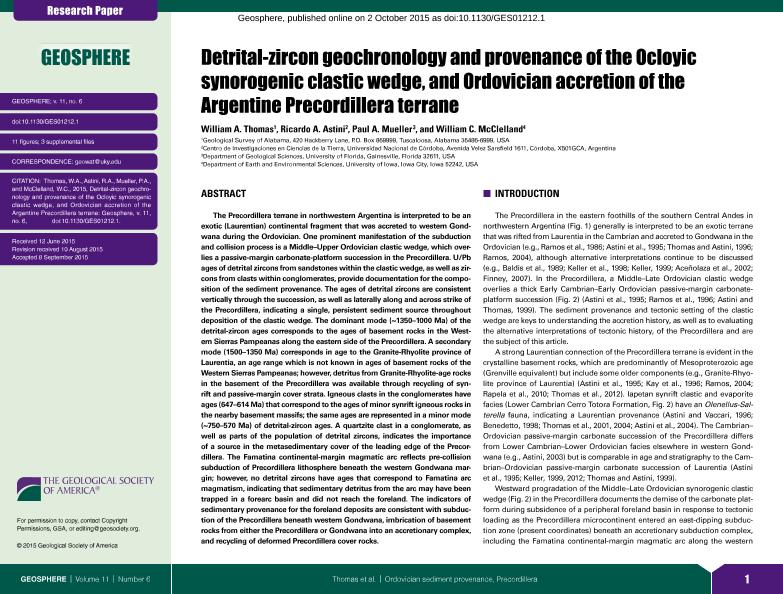Mostrar el registro sencillo del ítem
dc.contributor.author
Thomas, William A.
dc.contributor.author
Astini, Ricardo Alfredo

dc.contributor.author
Mueller, Paul A.
dc.contributor.author
McClelland, William C.
dc.date.available
2018-05-04T13:36:44Z
dc.date.issued
2015-10
dc.identifier.citation
Thomas, William A.; Astini, Ricardo Alfredo; Mueller, Paul A.; McClelland, William C.; Detrital-zircon geochronology and provenance of the Ocloyic synorogenic clastic wedge, and Ordovician accretion of the Argentine Precordillera terrane; Geological Society of America; Geosphere; 11; 6; 10-2015; 1749-1769
dc.identifier.issn
1553-040X
dc.identifier.uri
http://hdl.handle.net/11336/44111
dc.description.abstract
The Precordillera terrane in northwestern Argentina is interpreted to be anexotic (Laurentian) continental fragment that was accreted to western Gondwanaduring the Ordovician. One prominent manifestation of the subductionand collision process is a Middle?Upper Ordovician clastic wedge, which overliesa passive-margin carbonate-platform succession in the Precordillera. U/Pbages of detrital zircons from sandstones within the clastic wedge, as well as zirconsfrom clasts within conglomerates, provide documentation for the compositionof the sediment provenance. The ages of detrital zircons are consistentvertically through the succession, as well as laterally along and across strike ofthe Precordillera, indicating a single, persistent sediment source throughoutdeposition of the clastic wedge. The dominant mode (~1350?1000 Ma) of thedetrital-zircon ages corresponds to the ages of basement rocks in the WesternSierras Pampeanas along the eastern side of the Precordillera. A secondarymode (1500?1350 Ma) corresponds in age to the Granite-Rhyolite province ofLaurentia, an age range which is not known in ages of basement rocks of theWestern Sierras Pampeanas; however, detritus from Granite-Rhyolite-age rocksin the basement of the Precordillera was available through recycling of synriftand passive-margin cover strata. Igneous clasts in the conglomerates haveages (647?614 Ma) that correspond to the ages of minor synrift igneous rocks inthe nearby basement massifs; the same ages are represented in a minor mode(~750?570 Ma) of detrital-zircon ages. A quartzite clast in a conglomerate, aswell as parts of the population of detrital zircons, indicates the importanceof a source in the metasedimentary cover of the leading edge of the Precordillera.The Famatina continental-margin magmatic arc reflects pre-collisionsubduction of Precordillera lithosphere beneath the western Gondwana margin;however, no detrital zircons have ages that correspond to Famatina arcmagmatism, indicating that sedimentary detritus from the arc may have beentrapped in a forearc basin and did not reach the foreland. The indicators ofsedimentary provenance for the foreland deposits are consistent with subductionof the Precordillera beneath western Gondwana, imbrication of basementrocks from either the Precordillera or Gondwana into an accretionary complex,and recycling of deformed Precordillera cover rocks.
dc.format
application/pdf
dc.language.iso
eng
dc.publisher
Geological Society of America

dc.rights
info:eu-repo/semantics/openAccess
dc.rights.uri
https://creativecommons.org/licenses/by-nc-sa/2.5/ar/
dc.subject
Precordillera
dc.subject
Analisis de Cuencas
dc.subject
Geocronologia
dc.subject
Circones Detríticos
dc.subject.classification
Meteorología y Ciencias Atmosféricas

dc.subject.classification
Ciencias de la Tierra y relacionadas con el Medio Ambiente

dc.subject.classification
CIENCIAS NATURALES Y EXACTAS

dc.title
Detrital-zircon geochronology and provenance of the Ocloyic synorogenic clastic wedge, and Ordovician accretion of the Argentine Precordillera terrane
dc.type
info:eu-repo/semantics/article
dc.type
info:ar-repo/semantics/artículo
dc.type
info:eu-repo/semantics/publishedVersion
dc.date.updated
2018-04-17T16:41:08Z
dc.journal.volume
11
dc.journal.number
6
dc.journal.pagination
1749-1769
dc.journal.pais
Estados Unidos

dc.journal.ciudad
Boulder
dc.description.fil
Fil: Thomas, William A.. Geological Survey of Alabama; Estados Unidos
dc.description.fil
Fil: Astini, Ricardo Alfredo. Consejo Nacional de Investigaciones Científicas y Técnicas. Centro Científico Tecnológico Conicet - Córdoba. Centro de Investigaciones en Ciencias de la Tierra. Universidad Nacional de Córdoba. Facultad de Ciencias Exactas Físicas y Naturales. Centro de Investigaciones en Ciencias de la Tierra; Argentina
dc.description.fil
Fil: Mueller, Paul A.. Florida State University; Estados Unidos
dc.description.fil
Fil: McClelland, William C.. University of Iowa; Estados Unidos
dc.journal.title
Geosphere

dc.relation.alternativeid
info:eu-repo/semantics/altIdentifier/doi/http://dx.doi.org/10.1130/GES01212.1
dc.relation.alternativeid
info:eu-repo/semantics/altIdentifier/url/https://pubs.geoscienceworld.org/gsa/geosphere/article/11/6/1749-1769/132288
Archivos asociados
